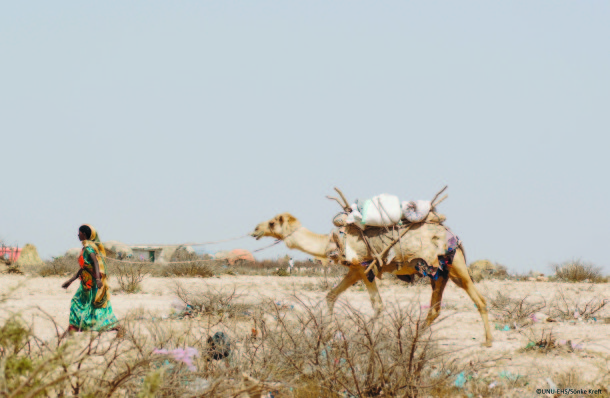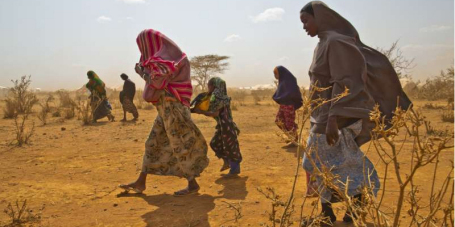Climate change, displacement and migration: short-term protection needs and long-term policy implications
Environmental and climatic conditions have always influenced global human mobility patterns. In a recent article, Piguet shows that many of the founders of migration studies between the late 19th and early 20th Century (among them Ratzel, Semple, Ravenstein, Huntington and Kropotkin) have included, implicitly or explicitly, environmental and climatic considerations among determinants of human mobility (Piguet 2013).
However, the natural environment has disappeared from migration studies for most of the twentieth century, only to reappear towards the end of the 20th Century and particularly in the last decade, after the publication of the Stern Review on the Economics of Climate Change and the Fourth Assessment Report of the Intergovernmental Panel on Climate Change (Stern 2006; IPCC 2007).

© Sönke Kreft / UNU-EHS
Most publications dealing with climate change, environmental change and migration still highlight the gaps in scientific understanding of the relationship between these three phenomena . However, an increasing number of researchers are studying how climatic and environmental factors, in combination with other social, economic and political factors, determine migration decisions (Foresight 2011).
I will briefly present two main reasons for the recent growing interest of scientists, policymakers and practitioners on this topic:
1. Protection gaps for persons displaced in the context of natural disasters and environmental degradation;
2. The potential for migration as part of effective household strategies to manage livelihood risks and to adapt to a changing climate;
I will then conclude by discussing the implications of climate change for migration patterns in rural agricultural areas of the Global South and highlighting the importance of coherent policies on short-term protection needs as well as long-term adaptation processes.
1. Displacement and legal protection gaps
This section aims to introduce a few key topics related to the legal status of people displaced in the context of natural disasters and climatic factors (eg. sea-level rise), namely:
1. Displaced persons leaving their country: “climate refugees”?
2. Relevant national legislation
3. Internally displaced persons.
Displaced persons leaving their country: “climate refugees”?
The term “climate refugee” is often used in the academic literature and in the discourse of international NGOs, in spite of not being established in any international legal text. This can partly be explained by the perceived urgency to bridge the protection gap of such people and the interest of many international environmental NGOs to show a “human face” of climate change.
The 1951 Geneva Convention (as amended by the 1967 Protocol) defines a refugee as someone who " [...] owing to a well-founded fear of being persecuted for reasons of race, religion, nationality, membership of a particular social group or political opinion, is outside the country of his nationality and is unable or, owing to such fear, is unwilling to avail himself of the protection of that country; or who, not having a nationality and being outside the country of his former habitual residence as a result of such events, is unable or, owing to such fear, is unwilling to return to it.” (United Nations 1967). Besides the proposal to extend the Geneva Convention to “climate refugees“, there is a broad consensus on the current refugee discipline not being applicable to persons displaced by natural disasters or other climate change-related issues.
Relevant National Legislation
No international agreement deals specifically with the rights of persons displaced in the context of natural disasters or other climatic/environmental stressors. However, some countries have designed policies to allow people whose countries have experienced natural disasters to stay in their territory, at least temporarily.
The list of relevant laws is definitely longer than the one below; only selected laws are mentioned which have been reported in the literature. It can be noticed that most of these laws do not guarantee a right for migrants to enter the state but only the right to stay if they are already in.
• The list of relevant laws is definitely longer than the one below; only selected laws are mentioned which have been reported in the literature. It can be noticed that most of these laws do not guarantee a right for migrants to enter the state but only the right to stay if they are already in.
• In Finland, the Aliens Act states that “aliens residing in the country are issued a residence permit on the basis of a need for protection if they cannot return because of an armed conflict or environmental disaster”;
• Sweden guarantees asylum to people who do not satisfy the requirements for the recognition of the refugees status but they are unable to return to their native country because of an environmental disaster;
• In Italy, article 20 of Legislative Decree nr 286 of 25.07.1998 states that temporary protection measures could be adopted on the occasion of natural disasters. This measure can be established through a Decree of the President of the Council of Minister which should be adopted in agreement with interested Ministers.
Internally Displaced Persons
The debate on the humanitarian consequences of climate change and natural disasters is still driven by political consideration related to the fear that millions of migrants induced by climate change from the Global South might invade the Global North.
Scientists agree that this fear is not founded and most climate change-related migratory movements will be internal to the states, except when internal migration is not an option (for example low-lying small island states). It is important to look at the legal status applicable to these internal migrants.
Internally Displaced Persons (IDPs) are defined by the United Nations Guiding Principles on Internal Displacement as “persons or groups of persons who have been forced or obliged to flee or to leave their homes or places of habitual residence, in particular as a result of or in order to avoid the effects of armed conflict, situations of generalized violence, violations of human rights or natural or human-made disasters, and who have not crossed an internationally recognized State border” (United Nations 1997) .
Internal migrants can thus obtain the status of IDP if environmental/climatic causes are recognised as natural disasters. Nevertheless, the Guiding Principles are not binding for UN member states hence it is up to individual states to protect IDPs in accordance with their legislation. Some states (and the African Union as a whole through the Kampala Convention) have decided to incorporate the Guiding Principles into their domestic legislation while others have not.
Way forward
In the case of internally displaced persons, the most important issue to enhance the protection of migrants seems to be the adoption by as many states as possible of the IDP Guiding Principles and its effective implementation.
Moreover, in October 2012, the governments of Switzerland and Norway have launched a state-led, bottom-up consultative process called “the Nansen Initiative ” which is a great step towards addressing the current protection gaps for people displaced internationally. The Initiative aims at building consensus on a protection agenda addressing the protection needs of people displaced across international borders by natural hazards, including the effects of climate change.
2. Migration, climate change adaptation and sustainable development in origin areas
An increasing number of studies have shown the potential of migration as part of strategies to manage livelihood risks and to adapt to climate change. This issue should be addressed in parallel with the problems related to displacement caused by natural disasters and the negative impact of climate change.
Many governments worldwide are now implementing policies to mobilise migrants for development of their areas of origin. In particular, several governments are trying to develop effective policies to involve the diaspora in national economic development, diaspora policies promote immigration and the return of skilled migrants and incentivise the effective use of it.
The same has not happened in the case of climate change adaptation. Chapter 20 of the Working Group II of the recently published Fifth IPCC Assessment Report talks about “climate resilient development pathways”, an idea that bridges the current gap between the climate change adaptation and sustainable development approaches (IPCC 2014). In this context, it will be crucial not only to unleash the potential of migration for development in a purely economic sense but also to make sure migration increases the adaptive capacity of sending areas which are often characterised by high prevalence of poverty and food insecurity.
Conclusion
Migration as part of an adaptive strategy should be promoted whenever it proves more effective than in situ adaptation options. In particular, migration of one or more household members can allow the whole household to diversify its livelihood and effectively manage risks. Moreover, short-term/seasonal mobility can allow people to stay in their communities of origin.
Natural disasters and climate change are likely to displace an increasing number of people. Their protection should be enhanced through the adoption of the Nansen protection agenda (international migrants) and adoption and effective implementation of the IDP Guiding Principles (internal migrants) (United Nations 1998). In the longer term, states should aim at harmonising the protection of people displaced by climate change and natural disasters internally and internationally.
Last but not least, the interaction between climatic and environmental factors and human mobility is not only about migration and displacement. The recent Foresight report (2011), for example, has shed light on the issue of people who might be unable to leave their area of origin in spite of severe environmental and climatic stressors, for example because of the lack of financial resources, and whose needs and problems have often been neglected in migration studies.
- Foresight (2011): Migration and global environmental change. Final project report. London: The Government Office for Science.
- IPCC (2007): Contribution of Working Groups I, II and III to the Fourth Assessment Report of the Intergovernmental Panel on Climate Change. Core Writing Team: Pachauri, R.K. e Reisinger, A. (a cura di), IPCC, Ginevra, Svizzera.
- IPCC (2014): Climate Change 2014: Impacts, Adaptation, and Vulnerability Summary for Policymakers of the Contribution of Working Group II to the Fifth Assessment Report of the Intergovernmental Panel on Climate Change.
- Piguet, E. (2013): From “primitive migration” to “climate refugees”: The curious fate of the natural environment in migration studies. Annals of the Association of American Geographers, 103(1), 148–162.
- Stern, N. (2006): Stern Review on The Economics of Climate Change, Cambridge University Press, Cambridge.
- United Nations (1967): Convention and Protocol Relating to the Status of Refugees.
- United Nations (1998): Guiding Principles on Internal Displacement. Addendum Report of the Representative of the Secretary General, Mr. Francis M. Deng, submitted pursuant to the Human Rights Commission resolution 1997/39 (E/CN.4/1998/53/Add.2).


